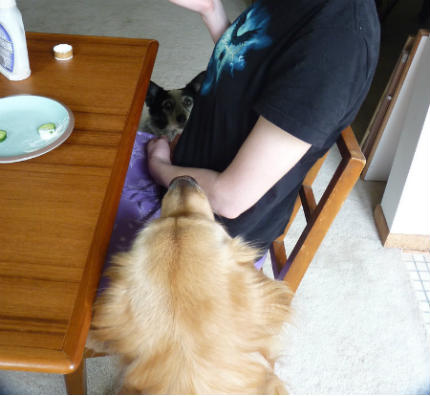The dog's digestive system has particular characteristics that make it very different from that of humans. We must keep in mind that its origin is carnivorous .
Today, in this post, we explain how it actually works through each of its different phases.
from the mouth
The conscious part of digestion begins from the snout, and from here its carnivorous qualities become evident, with its sharp teeth, marked incisors and powerful molars that help the dog begin to swallow food.

Although unlike humans and other species, in dogs, saliva does not have digestive enzymes that begin to break down food, so this process falls more on the internal organs.
For this reason, it is not easy for them to digest foods such as cereals. Thus, a true quality food for dogs, such as Lobo Azul food , is much easier for them to swallow due to its reduced grain content and its high proportion of meat , suitable even for human consumption.
through the esophagus
The esophagus is that tube through which food will begin to circulate through the dog's internal organs. In this case it is a long organ where a type of mucus is released that helps facilitate the advancement of the food. Although a system of contractions is also generated, through which the bolus is formed.
In the stomach
As usually happens in carnivores, there is only one stomach, but it is large in size , since both storage and digestion functions are fulfilled here.
It is in the stomach where food is stored long enough for gastric acids to do their job. It should be noted that in dogs, these acids are up to 6 times more corrosive than in humans, which is also motivated by their natural function to digest meat more easily , and likewise has greater resistance to bacteria. , such as those of decaying meat.

Gastric glands are distributed in the internal walls of the stomach, which release gastric acids that begin to carry out various chemical processes in the food; for example, promoting corrosion and subsequent absorption of proteins through these same ducts.
However, it is important to remember that proteins are broken down into amino acids. However, almost half of these cannot be synthesized by the dog, so it is necessary to provide them through their diet. For this reason, super premium dog food, such as Lobo Azul, is widely recommended by veterinarians, as it includes a proportion of different foods of both animal and plant origin , which allow them to cover all of their different nutritional needs .
Enzymes such as pepsin are also released in these glands, which transform both proteins and fats.
Covering the internal tissues of the stomach is a layer called connective tissue , which - among other functions - helps begin the distribution of nutrients to various parts of the animal's body.
through the liver
The liver is also large in dogs, as it also fulfills multiple functions. It stands out that bile is generated here, which is essential for digesting fats , before being stored by the gallbladder.
This vital organ also serves as a kind of warehouse, where reserves of various nutrients such as vitamins and minerals are stored.
Proteins and glucose are synthesized in the liver, and it has an essential function to eliminate toxic substances that have reached this point in the digestive system.
to the pancreas
Although it is a much smaller organ, it also performs important functions in digestion; particularly regarding the assimilation of fats , which has a major significance for dogs.

However, the dog's pancreas is also responsible for other functions such as regulating blood glucose levels .
Continues through the small intestine
It is the longest of the dog's organs, and due to its system with abundant intestinal villi, the space in square centimeters ends up multiplying even more.
This elongated shape allows the circulation of food to be regulated , as the flow of nutrients is also required; thus initiating most of the chemical digestion that takes place inside the dog.
It is made up of three main parts; The main function of the first is to receive gastric juices, in the intermediate phase nutrients are absorbed and the final section has the mission of leading to the large intestine.

Empties into the large intestine
This intestine is where most of the water ingested by the animal is absorbed , after it has also fulfilled lubrication functions throughout the digestive system.
Although this is where the waste from digestion is stored and finally expelled to the rectum area; And yes, the chemical processes that give this waste its characteristic smell are also generated here.
It should be noted that food that could not be digested can also reach the large intestine. For example, if you eat too many bones, it is likely that some pieces can reach this part almost whole, which can cause various damages. For this reason, these types of foods should be only sporadic or even avoided completely, and in no way form part of an abundant or regular diet.
As you can see, digestion in a dog has very particular characteristics that deserve a special diet. Its base has to be of animal origin, because without a good diet, which is mainly cereals and a minimum contribution of animal protein, you will be contributing to the deterioration of its health. On the other hand, applying a feed that takes into account the need for fats, proteins and is also complemented with essential vitamins and minerals, as is carried out in the production of premium feeds such as Lobo Azul , allows us to guarantee a more complete development. and healthy for your pet.
Other curiosities that may interest you:












